On an October morning in 2025, Paris woke up to the unimaginable: the Louvre Museum, home to centuries of royal treasures, had been robbed.
Eight dazzling pieces from France’s Crown Jewels vanished within minutes, leaving behind shattered glass and a nation in disbelief.
Beyond the headlines of daring thieves and broken alarms lies a deeper story, one of artistry, heritage, and craftsmanship that took generations to perfect.
The Stolen Treasures of Royal France
According to France’s Ministry of Culture, eight priceless jewels were stolen, each holding the memory of royal grace and the legacy of master craftsmanship.
1. The Crown of Empress Eugénie
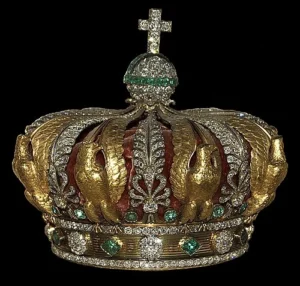
Created in 1855 by the renowned jeweler Alexandre-Gabriel Lemonnier, this crown embodied the grandeur of the Second Empire.
It was adorned with 1,354 diamonds and 56 emeralds, arranged in a floral garland design, a style that mirrored the romantic aesthetic of the era.
The crown symbolized Empress Eugénie’s elegance and her influence over European jewelry design.
Found damaged on the thieves’ escape route, it remains a haunting reminder of how fragile even the grandest legacies can be.
2. The Emerald Necklace and Earrings of Empress Marie Louise
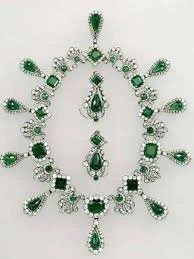
This stunning emerald parure, a necklace and pair of earrings, reflected the refinement of Napoleon Bonaparte’s second wife, Empress Marie Louise.
Each emerald was surrounded by rose-cut diamonds, capturing the soft light of 19th-century candlelit courts.
The craftsmanship highlighted the French mastery of stone pairing, where each gem was chosen not only for its color but also for its harmony with the design’s rhythm and flow.
3. The Sapphire Parure of Queen Marie-Amélie and Queen Hortense
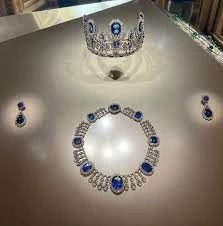
A parure, or coordinated set of jewels, was once the ultimate expression of royal sophistication.
This particular sapphire and diamond suite featured a deep-blue Ceylon sapphire centerpiece, surrounded by old-mine-cut diamonds.
Each piece was modular, meaning it could transform from a necklace into a tiara or brooch—an early example of innovation in design and function.
Its balance between bold gemstones and airy metalwork showed the precision of 19th-century French setters.
4. The Emerald and Diamond Tiara of Queen Hortense
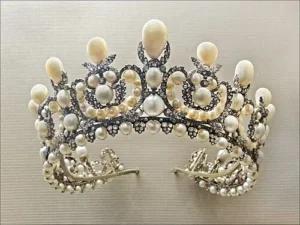
Queen Hortense’s tiara embodied the neoclassical style beloved by the French Empire.
Its emeralds, symbols of renewal and virtue, were arranged in a laurel motif, a nod to victory and divine grace.
The tiara’s delicate claw settings allowed maximum light to pass through the stones, creating a glowing effect that modern jewelers still try to emulate.
Its lightweight structure, known as a fine armature, revealed the early mastery of design engineering in high jewelry.
5.Empress Eugénie’s pearl tiara and diamond bow brooch
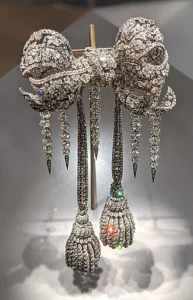
This exquisite gold, silver, and diamond bow brooch was once the centerpiece of a diamond belt made up of over 4,000 stones, first showcased at the Paris Exposition of 1855 on the Champs-Élysées.
Empress Eugénie later wore the transformed brooch for Queen Victoria’s visit to Versailles and at the baptism of her son, Louis-Napoléon Bonaparte — moments that marked both royal glamour and international diplomacy.
In the 1860s, Eugénie had the heavy diamond belt refashioned into a graceful bow, its cascading ribbons designed to descend to her waist — a style that perfectly reflected the Second Empire’s romantic femininity.
After the fall of the monarchy, the piece was auctioned in 1877 under the order of the Third Republic and purchased by Caroline Astor, a prominent figure of New York’s high society.
It passed through the hands of English aristocrats during the 20th century before finally being acquired by the Louvre in 2008, after the bankruptcy of jeweller Ralph Esmerian, for an estimated $10 million.
Why These Pieces Matter
Beyond their estimated value of €88 million, these jewels are irreplaceable chapters of history.
Each stone was hand-cut, each setting hand-forged, and each design steeped in symbolism, making them priceless artifacts of craftsmanship.
Their loss isn’t just about money; it’s a break in the lineage of art itself, a link severed between historic artisans and modern creators.
For today’s jewelry designers, gemologists, and manufacturers, the Louvre heist serves as a powerful reminder that:
While beauty can be recreated, history cannot be replaced.
A Legacy Beyond Loss
Even in their absence, these royal jewels are still inspiring.
Their silhouettes, gem pairings, and design techniques echo in modern collections, proof that craftsmanship transcends time.
The Louvre’s loss has reignited global conversations about museum preservation and design heritage while also reminding the world why such creations must be protected as living art.
The theft may have taken away their sparkle, but it cannot steal their story.
Read more stories on heritage, craftsmanship, and innovation at https://theigj.com/blogs/
